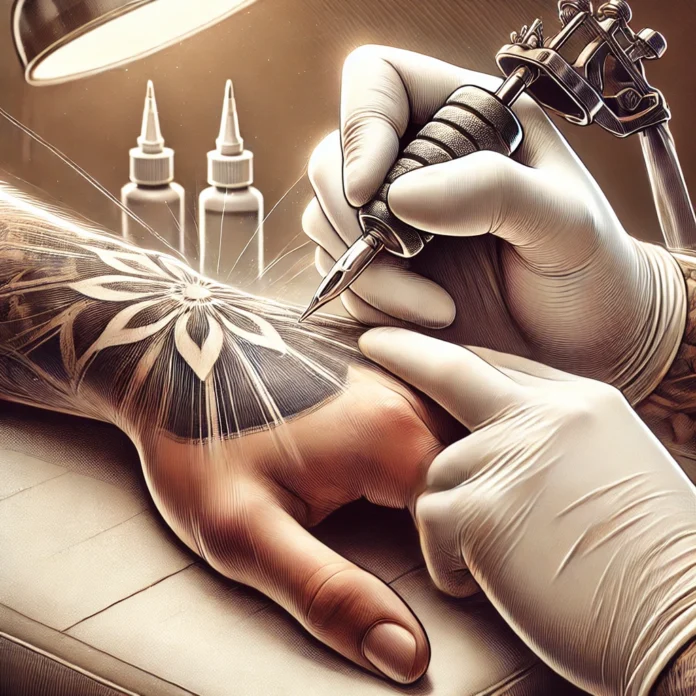Tattoos have become a global phenomenon, a unique way for people to express themselves. However, not all tattoos are created equal—especially when it comes to the pain factor. If you’ve ever wondered why white tattoo ink tends to hurt more than other colours, you’re not alone. This blog dives deep into the reasons behind this phenomenon, the challenges of aftercare, and tips to make the process more manageable.
Why Does White Tattoo Ink Hurt More?
White ink tattoos are striking, but many people report increased discomfort when getting them. The reasons are tied to both the nature of white ink and the tattooing process itself. Let’s explore some important points:
1. Thicker Consistency of White Ink
White tattoo ink is often thicker than other colors, which makes it more challenging for tattoo artists to work with. To achieve solid, vibrant results, the artist must go over the same area multiple times, which can irritate the skin more than usual.
2. Higher Needle Penetration
To make white ink appear on the skin—especially on darker or tanned skin tones—the tattoo artist needs to penetrate the dermis layer more deeply. This increased depth can amplify the pain compared to tattoos done with darker inks that require fewer passes.
3. Skin Sensitivity and Contrast
White ink contrasts heavily with most skin tones, making it harder to blend naturally. The artist’s focus on precision may lead to slower and more deliberate movements, prolonging the procedure and intensifying discomfort.
4. Location Matters
White ink tattoos are often used for delicate designs or highlights, which are commonly applied to sensitive areas like wrists, hands, or ribs. These areas naturally have thinner skin and more nerve endings, contributing to the increased pain.
5. Allergic Reactions to Pigments
White ink contains titanium dioxide, a pigment that’s more likely to cause allergic reactions. These reactions can lead to redness, swelling, and itching, making the tattooing process more uncomfortable.
The Pain Factor Behind White Tattoo Ink
Pain perception varies from person to person, but certain factors are universal. The intensity of pain for white tattoos can also be influenced by these factors:
- Tattoo Design: Intricate designs with heavy shading in white ink often require more time and precision.
- Skin Type: Sensitive skin types are more prone to irritation, increasing the perception of pain.
- Tattoo Artist’s Technique: The skill and experience of the tattoo artist play a significant role. Inexperienced artists might press too hard, causing unnecessary discomfort.
Understanding these factors can help you prepare for the experience and minimize discomfort.
Aftercare Challenges
Caring for a white ink tattoo can be more challenging than other tattoos. This is because white ink is prone to fading, discoloration, and patchiness. Improper aftercare can intensify these issues, making healing more painful and complicated.
Why Aftercare Matters More for White Ink
- Higher Sensitivity: The skin’s increased sensitivity after multiple passes with the needle can make aftercare critical.
- Prone to Infection: The deeper penetration required for white ink tattoos makes the skin more susceptible to infections.
- Sunlight Exposure: White ink fades faster under UV exposure, so protecting the tattoo with sunscreen or clothing is essential.
Important Tips to Stop the Hurt
While pain is an inevitable part of the tattooing process, there are steps you can take to minimize it. Here are some essential tips:
- Choose an Experienced Artist A skilled tattoo artist who has experience working with white ink can make a world of difference. They’ll know how to apply the ink effectively while minimizing discomfort.
- Prepare Your Skin Make sure your skin is well-hydrated and free from irritants before your appointment. Avoid alcohol and caffeine as they can thin your blood, leading to more sensitivity.
- Using Numbing Cream Over-the-counter numbing creams can help reduce the pain during the session. Discuss this option with your tattoo artist beforehand.
- Follow Aftercare Instructions Religiously Proper aftercare can minimize inflammation and prevent complications. This includes keeping the area clean, applying recommended ointments, and avoiding scratching or picking at the tattoo.
- Stay Relaxed Tension and stress can make pain feel worse. Try to stay calm and focus on your breathing during the session.
Healing Time
Healing times for white ink tattoos are often longer than other tattoos due to the deeper penetration and multiple passes. Typically, white ink tattoos take about 2-3 weeks to heal on the surface and several months for complete internal healing.
What to Expect During Healing:
- Scabbing and Peeling: These are normal parts of the healing process but might appear more pronounced with white ink.
- Fading During Healing: It’s common for white ink to look patchy or less vibrant as it heals.
- Moisturize Regularly: Keeping the tattoo moisturized can speed up healing and reduce discomfort.
Conclusion
White ink tattoos are undeniably beautiful but come with their own set of challenges, particularly regarding pain and aftercare. By understanding why white ink hurts more, preparing yourself, and following proper aftercare, you can ensure a smoother tattooing experience and enjoy the results for years to come. Remember, the temporary discomfort is worth it for a piece of art that’s uniquely yours.
FAQs
1. Does white ink hurt more than black ink?
Yes, white ink generally hurts more due to its thicker consistency, the need for deeper needle penetration, and the multiple passes required to make it stand out.
2. Why does white ink fade faster?
White ink is more susceptible to UV rays and environmental factors, causing it to fade faster than darker inks. Proper aftercare and sun protection can slow down the fading process.
3. Can I reduce the pain of getting a white ink tattoo?
Yes, you can reduce pain by choosing an experienced artist, using numbing creams, staying hydrated, and following aftercare instructions meticulously.
